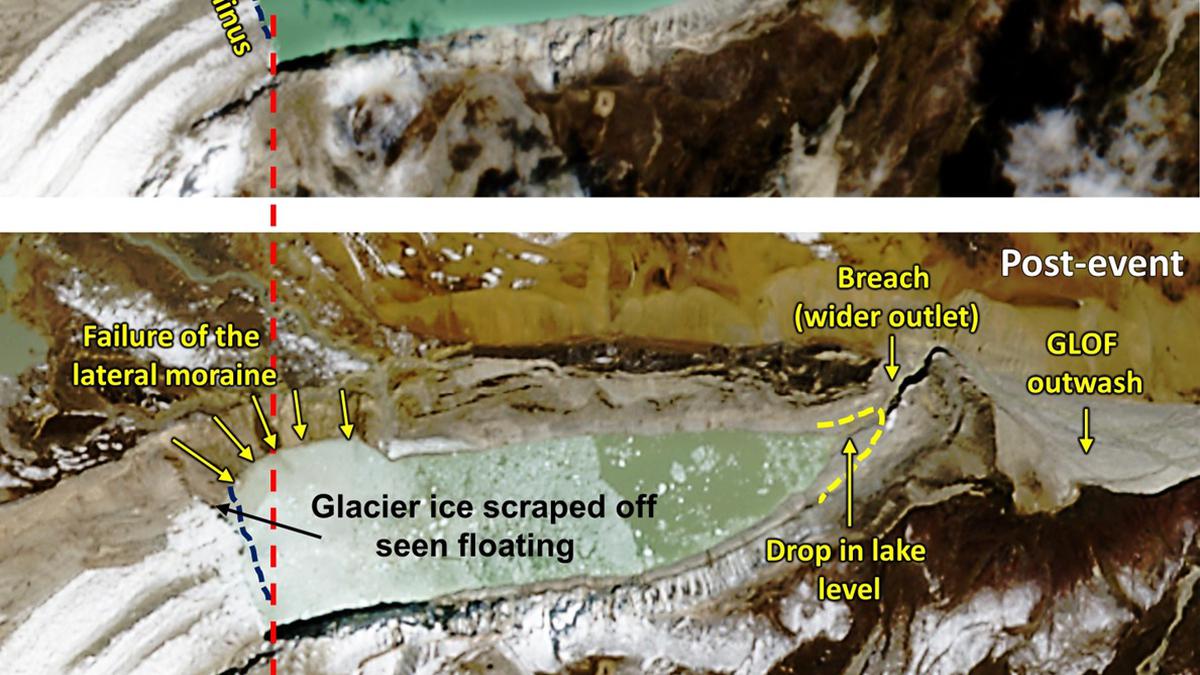
In the Sikkim flood’s wake, a trail of hazards lie in wait
The Hindu
A GLOF at South Lhonak lake in Sikkim caused 42 deaths. The lake remains a potential hazard due to its size and the melting glacier. Scientists are currently studying the effects of the GLOF and a landslide-dammed lake downstream of the lake. A cloudburst is unlikely to have been the flood’s cause. Instead, climate change and hydroelectric power dams in the lake’s neighbourhood may have contributed to the disaster.
The South Lhonak lake in the Himalayan state of Sikkim breached on the night of October 3, resulting in a glacial lake outburst flood (GLOF) that ravaged four districts. At least 42 people died as a result and 77 more are still missing. More than a month after the disaster, the lake remains a potential hazard, say scientists.
The South Lhonak lake is located in North Sikkim, at an altitude of 5,200 m. According to scientists, the current interpretation of the flood – which relies heavily on satellite data – suggests that on October 3 night, a slope failure occurred along the lateral moraine (a mass of debris and rocks) on the lake’s left bank. Preliminary research found that some of the landslide material scraped the glacier terminus; most of it hit the lake, creating an impulse wave that moved towards the lake’s narrow front end.
It widened the lake’s outlet, resulting in a partial breach, said Ashim Sattar, a mountain hazard specialist who is currently studying the GLOF and has authored research articles predicting different GLOF scenarios for the South Lhonak lake. There was also a probable overtopping as water moved over the moraine along the lake’s outlet. The result was a GLOF that affected around 88,400 people in Sikkim’s Mangan, Gangtok, Pakyong, and Namchi districts.
The lake is one of the largest and fastest growing glacial lakes in Sikkim, and has been a potential hazard for several years now. Dan Shugar, a geomorphologist from the University of Calgary in Canada, who is currently conducting research on the GLOF, noted that before the flood, the lake’s area was 1.62 sq. km, and after water being drained out in the GLOF, the area dropped to 1.46 sq. km.
Dr. Sattar said, “While the lake level was lowered due to the flood, it did not drain completely. A lot of water still remains in the lake, making it a potential hazard.”
Adding to the existing hazard, weeks after the disaster, there have been continuous landslides along the slope that first failed on October 3, Dr. Shugar added.
When the flood gushed through the valley, it triggered a landslide about 30 km downstream of the South Lhonak lake, which blocked the river, forming a landslide-dammed lake. After reviewing satellite images, Dr. Sattar surmised that the lake had not drained even by November 1.

In a study published in the journal Mammalian Biology on December 23, 2024, researchers compared the calls of Asian elephants based on their age, sex, and behaviour. They found the duration of trumpets remained fairly consistent across all age classes for both male and female Asian elephants but roars and roar-rumbles got longer with age.

The STS-63 mission, more popularly dubbed as the near-Mir mission, was a successful mission that spanned from February 3-11, 1995. A mission that served as a dress rehearsal for later missions that would rendezvous and dock with Mir, STS-63 reeled off a number of firsts. A.S.Ganesh tries and lists them out for you…











